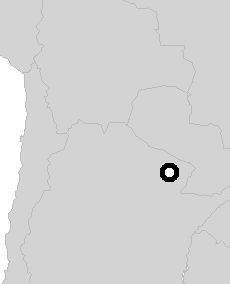
| www.CuriousTaxonomy.net |
|
The Flood in World Myth and Folklore
Gran Chaco |
| © 2021 Mark Isaak |

Rainbow does not like menstruating women to enter the water, or even to drink from it. One day a young woman broke this taboo because her mother and sisters didn't leave her any drinking water when they left for the day. Driven by thirst, she went to the lagoon. When she had returned, Rainbow, full of anger, caused a strong wind, accompanied by whirlwinds and heavy rain. All were drowned in the ensuing flood.
Bierhorst, 1988, 142-143.

A woman having her period, according to custom, stayed in her hut with her head covered. She was terribly thirsty, but her mother and other women had gone to pick fruits and carob pods. She put a cloth over her head, another between her legs, and went to fetch water at the well. It was such a small well that she did not thing she did wrong.
On returning, as she drank from the calabash, she saw at its bottom the eyes of an ik, a snake with large mouth and teeth. The snake is the rainbow itself. She was horrified and told her mother about it later. "So it's going to rain," the mother said.
Indeed, that evening it began to rain, and it rain continuously. The rainbow appeared. The ground became soft, and the village, with huts, people, and animals, sank into it. When everything had been engulfed, the ground returned as it had been before.
Some time later, a man passing there was surprised that the village he knew was no longer there. He heard, from underground, a rooster crowing, a dog barking, and a goat bleating. He returned and told that the people of the village had changed to beasts and continue to live underground.
One man had managed to escape by climbing a carob tree. He stayed there a long time because he dared not sleep alone on the ground. After some time, he went looking for the beast and arrived at where the rainbow-snake was. He made an arrow of cikua wood and told it to strike the ik in the eye. Since he was a shaman, the arrow went straight into the eye. The wounded snake writhed on the ground, and he finished it off with an axe.
Alfred Métraux, "Entretiens avec Kedoc et Pedro," in Religions et magies indiennes d'Amérique du Sud (Paris: Gallimard, 1967), 138-139 [117-159].

A girl went to wash clothes in the river, but she was menstruating. And this was tabu and would bring misfortune. And indeed the girl did offend the Master of the Water. Soon after she returned, her house crumbled because water undermined it, and she and all her family died.
Luis D. Heredia, "Aportes para la comprensión del chamanisomo toba", Anthropos 90 (1995), 470.

Fox told Lampalagua, the water python, that he was a supernatural being and refused to give him any food. Lampalagua went off to see Rainbow and told him what Fox was claiming. "Let's go see him," Rainbow said. Rainbow went where Fox was and caused a flood, extinguishing Fox's fire and washing away his house. Fox climbed an algarrobo tree.
"Why are you in a tree?" Rainbow asked him, "Aren't you boasting to be a supernatural being?"
"I am a supernatural being. I am master here. I shall stay here until the flood recedes."
"It may never recede. Will you stay here forever?"
"Yes," said Fox. He turned round and round on a branch and turned into an anthill.
Carancho, from a nearby village, heard Fox and Rainbow arguing, so he knew a storm was approaching. He went to see. He could not find Fox until Fox said, "I am in this little hut," and Carancho saw the anthill. He returned to tell the people that Fox had been changed into an anthill. The people went and threw dirt clods at it, destroying it.
Later a big ant appeared in the village and said, "Tomorrow an epidemic will break out here, and you will all start itching." Carancho went and burned the anthill, and there was no epidemic.
Johannes Wilbert and Karin Simoneau, Folk Literature of the Toba Indians (Los Angeles: UCLA Latin American Center Publications, 1982), 1: 257-259.
